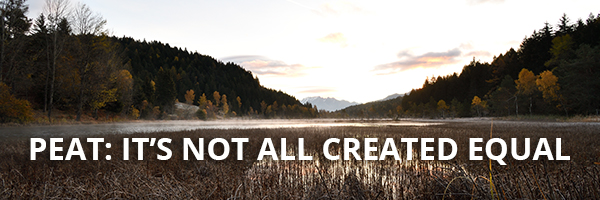
Peat seems to be one of those terms like “plastic.” We use it as a catch-all, whether we’re talking about polyethylene terephthalate in our soda bottle or polyvinyli3dene chloride in our cling wrap. Just as those types of plastic have different forms and functions, the term “peat” can also be described more specifically depending on its origin, degree of decomposition and use.
Peat is partially decomposed plant matter, but even the term “plant matter” is broad. In general, peat is
composed of either vascular or nonvascular plants.
Vascular Plants
- Grasses, reeds, sedges, ferns, non-woody broadleaf species
- Strong cellular structure transports water and nutrients throughout the plant
- Faster Decomposition
Non-Vascular Plants
- Mosses and low-growing species
- Move water and nutrients through the plant through specialized cells
- Slow decomposition
The different types of plant structures give rise to different physical and chemical characteristics, and those differences are critical in some uses of peat.
Peat can also be described by its degree of decomposition. Consider again how plants decompose. The
plant becomes smaller and smaller over time as animals and microorganisms break down its structure.
Eventually, the plant structures become so small and decomposed that they are no longer recognizable.
In sapric peat, only a small fraction of the plant structures can be identified, and if you squeeze it in your fist, mud will ooze out between your fingers. In fibric peat, many of the plant structures such as roots and stems are still visible and identifiable. If you squeeze fibric peat in your fist, water might escape your grasp, but the peat would remain in your hand. Hemic peat is the middle ground.
The degree of decomposition can be impacted by many factors. Certainly, the most intuitive is the age of the peat; given enough time, the plant will decompose into muck. Other factors like hydrology, climate, the plant type and even the presence of other species can impact how readily plants decompose.
This is all good and well, but what does it all mean where it matters most, at the cash register? “Peat moss” is probably the most widely used term related to peat. Peat moss, or moss peat, can be found in the horticulture area of most improvement stores. As the name implies, the plant origin is moss, and most of the time, the peat is fibric. It is usually the most acidic type of peat. Occasionally, bags of reed-sedge peat can be found in stores. The plant origin, in that case, is vascular plants such as reeds, sedges and grass. Reed-sedge peat is also sold under different names – topsoil, garden soil, etc. – and with additional components such as compost and manure. Peat from vascular plants such as reeds and sedges is most often hemic and resembles dark, rich soil with a more neutral pH.
Peat moss and reed-sedge peat are both good soil amendments – each increases the water holding capacity of soils and improves soil texture.

The differences between moss and reed-sedge peats become more critical in some of the value-added uses of peat, such as oil sorbents, water treatment products or microbial carriers. For instance, Sphagnum moss peat is an effective oil sorbent, and reed-sedge peat naturally removes heavy metals from water. If the goal is a soil amendment, almost any type of peat will drive improvements, but, if using peat for a more technical or engineered product, its origin and degree of decomposition become critical.
APT harvests hemic reed-sedge peat to make our engineered granular products. We transform that raw material into premier microbial carriers and water treatment medias that harness the peat’s natural characteristics to improve soil health and water quality, respectively. If you’re interested in learning more about our product lines, please feel free to dive deeper into our agricultural and water treatment solutions. Or, reach out to the APT team at any time at info@americanpeattech.com or (218) 927-1888.
